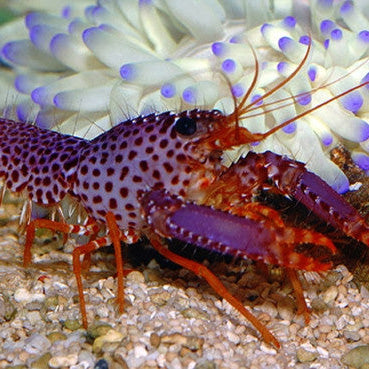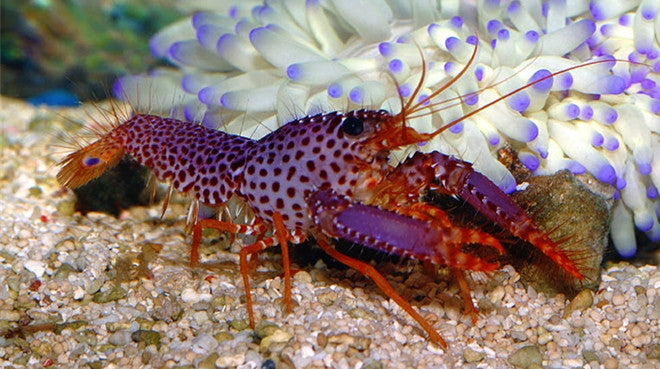Everyday low prices. Free Shipping Over $249. Or $29.99 Flat Rate Over $100
Purple Lobster
$ 49.99 $ 59.99
Please select all options.
How to Care for Purple Lobster
written by Dave Burr
Provide the Purple Lobster with a deep sand bed and numerous rocks where it can construct its burrow. A hiding place is especially important after molting when the lobster must wait for its new exoskeleton to harden. Constructing a cave near the front of the aquarium will improve your chances of seeing the lobster during the day as it will spend most of the daylight hours hiding in its burrow.
Behavior: Purple Lobsters will not bother corals, but may harm small passive reef fishes and some smaller invertebrates. They are highly territorial and are best kept singly. Two or more will often fight unless they are a mated pair. They grow to a maximum size of five inches in the wild, but should not grow as large in an aquarium.
Feeding: The Purple Lobster is a omnivore and a great scavenger. It will help to keep your aquarium clean by eating excess food left over by the fish.
Molting: Maintaining proper pH, Ca, Alk, & Mg levels is important for lobsters. Providing additions of iodine will help the lobster to molt and grow.
Care Level: Easy
Reef Compatible: Add with caution
Diet: Omnivore
Range: Indo-Pacific
Family: Nephropidae
Water Conditions: 75-80° F; sg 1.024-1.026 (1.025 is ideal); pH 8.1-8.4 Ca 420-440 ppm, Alk 8-9.5 dKH, Mg 1260-1350, Nitrates <10ppm, Phosphates < .10ppm
Water Chemistry: It is important that proper calcium (420-440 ppm), alkalinity (8-9.5 dkh - run it 7-8 if you are carbon dosing) , and magnesium levels (1260-1350 ppm) are maintained. Raising magnesium levels gradually up to 1400-1600 ppm can help to combat algae outbreaks, just keep CA and Alk in line as you raise the Mg. Nitrates should be below 10 ppm and phosphates should be below .10 ppm. We recommend doing a water change when Nitrate levels rise to 10 ppm. It is important to replace your phosphate media when phosphates rise to .10 ppm. Media Reactors make the most efficient use of your phosphate media by fluidizing it.
Dosing: Vivid Aquariums uses and recommends dosing pumps to automate the dosing of additives and keep your levels more constant. A dosing pump can alleviate the chore of manually dosing your aquarium with Ca, Alk, & Mg 2,3, or 4 times per week and will benefit your aquarium by keeping your levels constant through frequent small additions of Ca, Alk, & Mg. Our tanks all progressed when we switched from 3 manual dosings per week to 70 automatic dosings per week and we got a lot more work done.



